Parrots (order Psittaciformes) are one of the most colorful groups of birds — and of all animals! — on the planet. You can find every color of the rainbow and more in this diverse avian order of over 400 living species. Some parrots are mostly just one body color, while many others display a combination of colors on their plumage. There are even a few species like scarlet macaws and rainbow lorikeets that are basically flying rainbows! Read on to find out how parrots can make so many different colors and how they rank in relative rarity.
#1 Green

These yellow-crowned amazons (
Amazona ochrocephala) are covered in iconic “parrot green.”
©iStock.com/GlobalP
Green is by far the most common color seen in parrots across the world. However, parrots don’t actually make green pigment — in fact, only a handful of bird species can. Rather, parrots can make their feathers green in one of two ways. One is to give their feathers a subtle olive tinge through a combination of yellow and black/brown pigments. The other is to combine yellow pigment and blue structural color (see #2 and #3 below) to produce shades of bright “parrot green.” Many parrots have green as at least part of their plumage. Furthermore, a good number of them sport it as their primary body color. In fact, there is only one parrot family where the color is curiously absent — the cockatoos (family Cacatuidae). However, they make up for it by commonly having other colors that are much rarer in other parrots!
#2 Red, Orange, Yellow
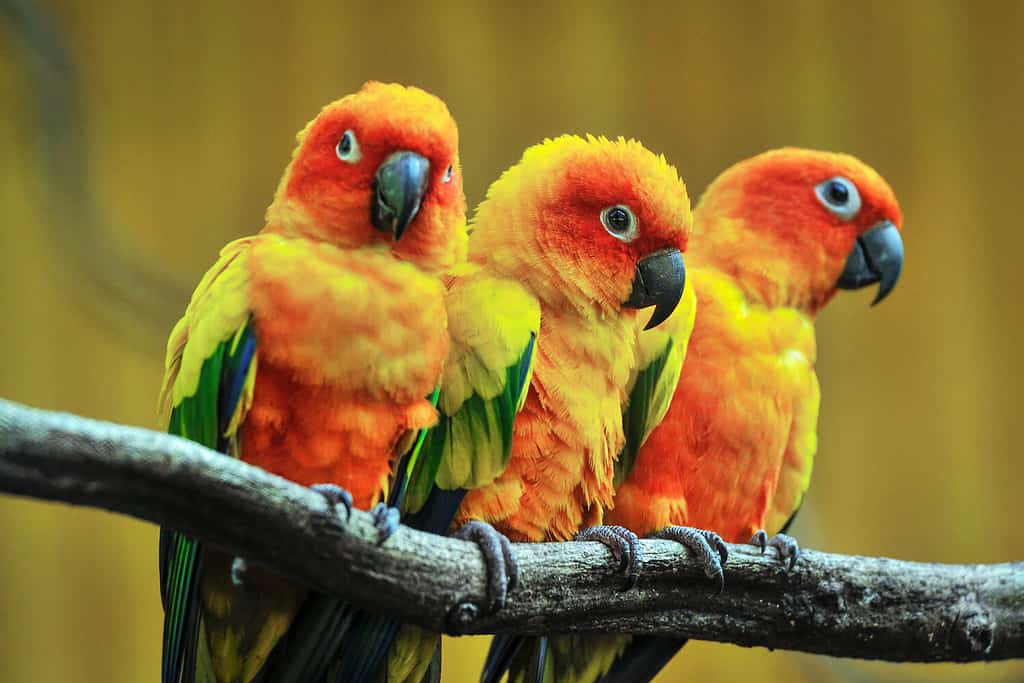
Sun conures (
Aratinga solstitialis) take full advantage of their order’s unique psittacofulvin pigments to produce vibrant citrus-colored feathers.
©Yatra4289/Shutterstock.com
For many birds, their red, orange, and yellow colors are the result of pigments called carotenoids, which they obtain through their food. Parrots, however, get these colors differently. They have their own unique pigments, called psittacofulvins, which cover the same color spectrum that carotenoids do. Unlike carotenoids though, these pigments are made by the parrots’ bodies rather than obtained through diet. These colors are therefore commonly found in the plumage of many parrots. Some parrots for whom these hues are the primary body coloration include lories in the Eos genus, cardinal lory (Pseudeos cardinalis), Pohnpei lorikeet (Trichoglossus rubiginosus), golden parakeet (Guaruba guarouba), and sun conure (Aratinga solstitialis).
#3 Blue
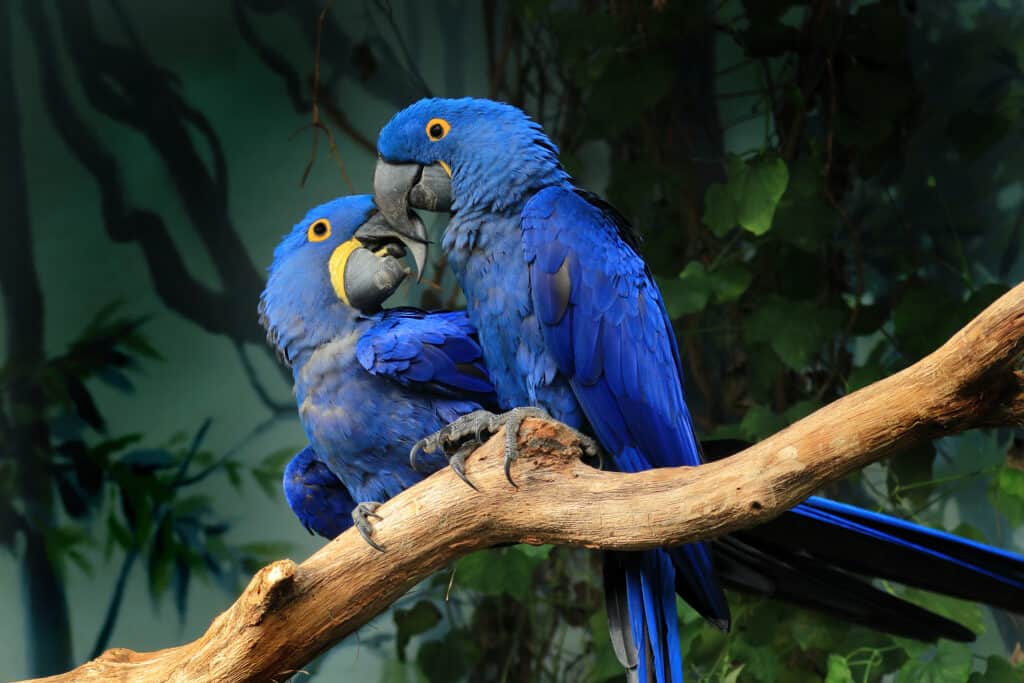
Hyacinth macaws (
Anodorhynchus hyacinthinus) are one of the few primarily blue parrots.
©Vaclav Matous/Shutterstock.com
Blue is another common color in the parrot world, although it is more often seen as a part of a multicolored plumage rather than the main body color. There are relatively few primarily blue parrots, including the blue macaws (Anodorhynchus and Cyanopsitta spp.), blue lorikeet (Vini peruviana), and ultramarine lorikeet (Vini ultramarina). These beautiful blues are not biological pigments, but rather structural color that is purely a trick of optics. Similar to how the sky and ocean can also look blue to us, these birds’ feathers refract light in just the right way to appear blue to our eyes. In fact, blue feather pigments simply don’t exist in the bird world, so every “blue” bird you see uses this same trick of structural color to fool your eyes!
#4 Black, Gray, Brown
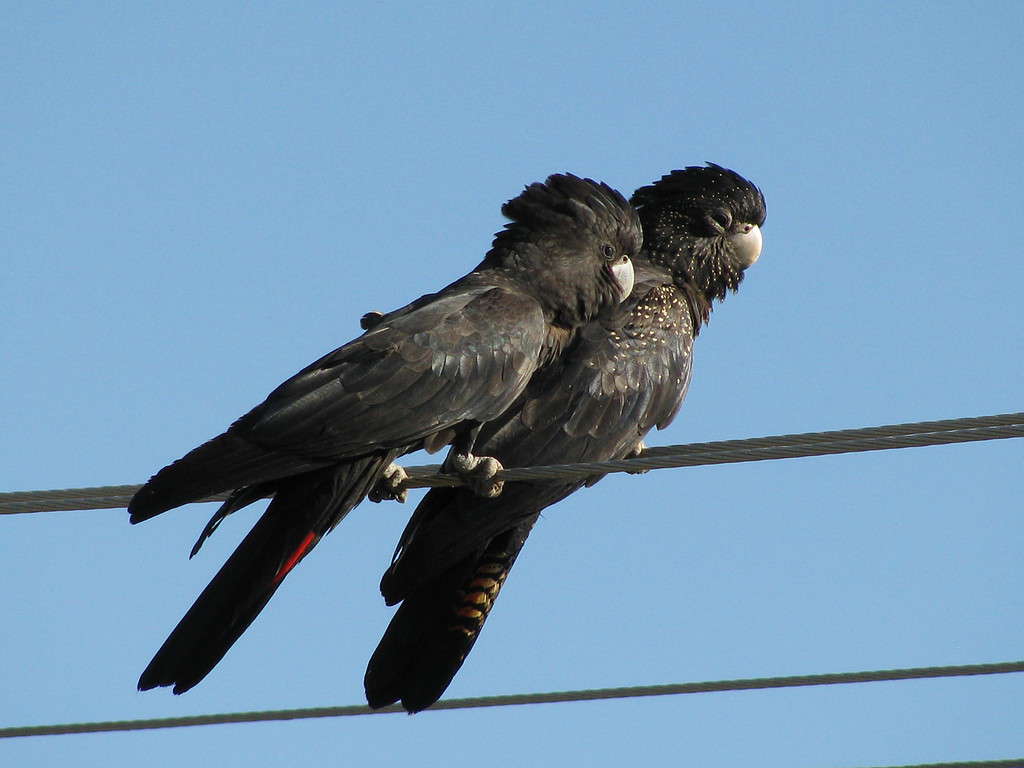
These red-tailed black cockatoos (
Calyptorhynchus banksii) are one of several black cockatoo species.
©gaab22 / CC BY 2.0 – License
These colors come from biological pigments known as melanins. Melanins are common pigments throughout the bird world — and indeed, in all vertebrates, including us humans! These are the same pigments that give us our range of hair and skin color. Eumelanin is the darker “black” version of melanin, which can also produce gray when diluted. Meanwhile, phaeomelanin is the lighter “brown” version, although it can also produce ruddy reds and sandy yellows (again, think human hair color). While blacks, grays, and browns are fairly common as small areas of parrot plumage, they are relatively rare as primary body colors. Notable exceptions include the black and grey cockatoos of the Cacatuidae family, African grey parrots (Psittacus spp.), black lory (Chalcopsitta atra), brown lory (Chalcopsitta duivenbodei), Pesquet’s parrot (Psittrichas fulgidus), Rüppell’s Parrot (Poicephalus rueppellii), and vasa parrots (Coracopsis spp.).
#5 White
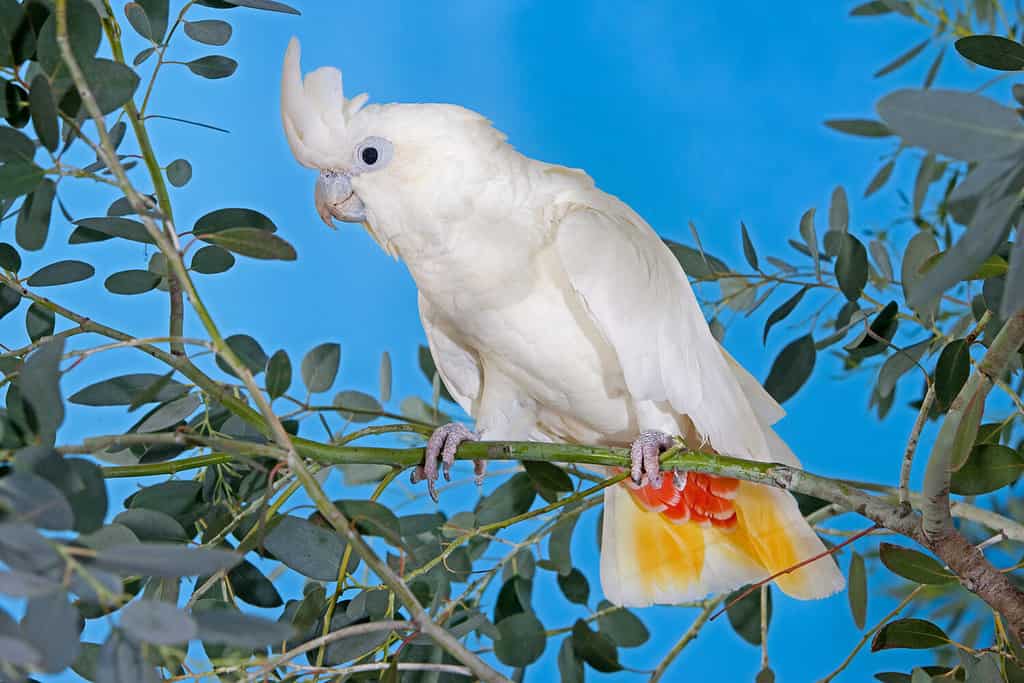
White cockatoos such as this Philippine cockatoo (
Cacatua haematuropygia) are the only primarily white parrots, although many also have some psittacofulvin highlights.
©slowmotiongli/Shutterstock.com
If a feather is lacking in both pigment and structural color, it will just appear white. While white highlights are not uncommon in the parrot world, large areas of white plumage are seldom seen (except when caused by a genetic mutation such as leucism or albinism). Furthermore, there is only one group of parrots for whom it is their primary body color, the aptly named white cockatoos (Cacatua spp.).
#6 Pink
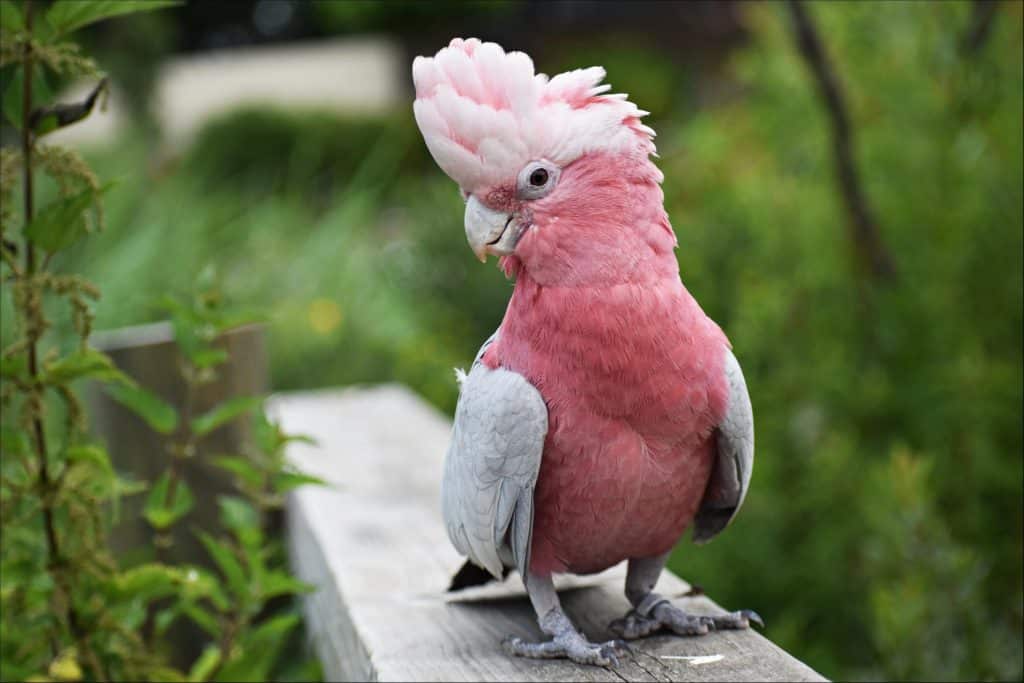
The galah (
Eolophus roseicapilla) is one of only two truly “pretty in pink” parrots.
©Gabriela Beres/Shutterstock.com
Pink is usually just a diluted red pigment on an otherwise white feather. It is a rather rare color in the parrot world, with only a small number of parrots having a bit of it in their plumage. There are only two species for whom it forms part of their primary body color, and they’re both cockatoos. These two are the galah (Eolophus roseicapilla) and pink cockatoo (Cacatua leadbeateri).
#7 Purple/Violet
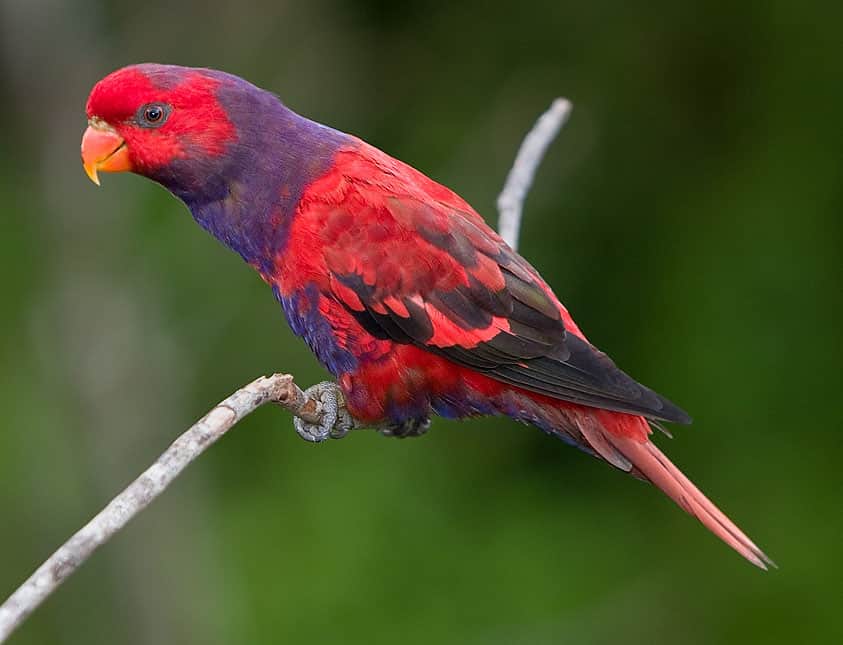
The violet-necked lory (
Eos squamata) is one of the few parrots with a significant amount of purple plumage.
©Doug Janson / CC BY-SA 3.0 – License
Purple is perhaps the rarest color in the parrot world. Just as layering yellow pigment and blue structural color creates green, so too does the combination of red pigment and blue structural color produce purple. There are no primarily purple parrots though, and only a smattering of species that display shades of it in their plumage. These include some female eclectus parrots (Eclectus spp.), some species of lories (Loriini tribe), blossom-headed parakeet (Himalayapsitta roseata), plum-headed parakeet (Himalayapsitta cyanocephala), imperial amazon (Amazona imperialis) and vinaceous-breasted amazon (Amazona vinacea).
Conclusion

While military macaws (
Ara militaris) dress in simple parrot green uniforms, their cousins the scarlet macaws (
Ara macao) prefer to wear rainbows.
©xtrekx/iStock via Getty Images
Parrots get their colors from a combination of biological pigmentation and structural coloration. Green is by far the most common color, created by either mixing pigments or layering pigment and structural color. Red, orange, and yellow are also common, thanks to parrots’ unique ability to make these pigments themselves. Structural color gives many parrots a bit of blue, but relatively few are mainly this color. Melanin pigments create black, gray, and brown feathers, while the lack of any color leaves feathers white. Both are relatively common as elements of plumage, but uncommon as primary body colors. Shades of pink created by diluted red pigments are rare, with only two cockatoos making it their main color. However, purple is even rarer, with no primarily purple species and only a few who have at least a bit.
Summary of Parrot Colors: Most Common to Rarest
| Color | Made By | Rarity |
|---|---|---|
| green | mixing of yellow pigment and melanins (olive tinge); mixing of yellow pigment and blue structural color (bright green) | most common plumage color in all parrot families except cockatoos, including many species with majority green coloration |
| red, orange, yellow | psittacofulvins (unique parrot pigments) | widepsread as a plumage color in all parrot families; primary body color in some species |
| blue | structural color | common in most parrot families as part of plumage; primary body color of blue macaws, blue lorikeet, ultramarine lorikeet |
| black, gray, brown | melanin pigments | common in most parrot families as part of plumage; primary body color of black/grey cockatoos and a handful of other species |
| white | lack of any pigment or structural color | found in some parrot families as part of plumage; primary body color only in white cockatoos |
| pink | diluted red pigment | uncommon plumage color in parrots; primary body color only in galah and pink cockatoo |
| purple | mixing of red pigment and blue structural color | not found as primary body color in any parrot; rare plumage color in only a small number of parrot species |
The photo featured at the top of this post is © Tramont_ana/iStock via Getty Images
Thank you for reading! Have some feedback for us? Contact the AZ Animals editorial team.






